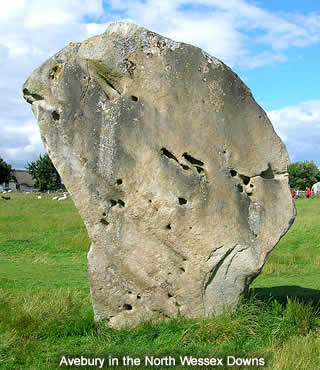North Wessex Downs |
|
 |
|||
Britain > Southern England > North Wessex Downs |
||||
A stomping ground for prehistoric man |
||||
|
||||
The North Wessex Downs is, at 666 square miles, the third-largest Area of Outstanding Natural Beauty in England. It's spread out over parts of Berkshire, Hampshire, Oxfordshire and Wiltshire - but not Wessex, which, despite sounding like one, isn't actually a real county. It is, however, an old name for this part of the country, and it makes for a catchy title. |
||||
The Downs' wide expanses of upland dip into farmed valleys and oak forests. This is one of the most fertile places in the country. Humans have lived here since at least 3000BC; for evidence of that fact, just look at Avebury. It's the largest stone circle in Europe, and Britain's second most famous Bronze Age monument, after Stonehenge. Like its more well-known cousin, Avebury's purpose is unknown. Perhaps it was a place of worship, or a ruler's platform. At any rate, it's a World Heritage Site, in the care of the National Trust. |
||||
Not far from here is Silbury Hill, a man-made mound of earth. In the present, all you'd need to build such a thing would be a construction vehicle and a couple of days - but back in the prehistoric era, that same job would have taken an enormous amount of work. The hill is similar in size to the smaller Egyptian pyramids. It's one of the largest mounds of its age in the entire world. |
||||
A few centuries later, humans got arty. They created drawings on a huge scale, by digging out trenches and filling them with crushed white chalk. The best example is the White Horse of Uffington, which is over 110 metres long. |
||||
Another local landmark is Watership Down, a hill in Hampshire. It was the setting of Richard Adams' famous 70s novel, also called Watership Down. He grew up around here, and the area inspired his story. The book's stars are a family of rabbits, whose struggles and triumphs are compellingly human. The novel was turned into a film, and has since become one of the best-selling books of all time. |
||||
In real life, rabbits share the Downs with lots of other wildlife. The hills are all made of chalk, which supports good-quality turf. This provides the right conditions for rare butterflies and flowers. |
||||
The chalk grassland is also the perfect surface for horse racing. There are plenty of courses and training fields within close proximity to each other, as well as dozens and dozens of stables. In Lambourn village, nearly every resident is involved in the industry, from highly-paid trainers to teenage stable boys. |
||||
One of the bigger settlements in the Downs is Marlborough, a dozen miles south-west of Lambourn. It's a traditional market town, with a famously wide high street. It has to be big, to fit in all the stalls and traders which flock here on Wednesdays and Saturdays. |
||||
The best way to explore the Downs is via your own two feet, on walking routes like the Ridgeway National Trail. This 87-mile path starts near Avebury, and heads out through the Chiltern hills. There has always been some sort of trail here - in fact, some describe it as Britain's oldest road. Still, it was only in 1972 that this became an official National Trail. It passes by all the ancient monuments and beautiful views that make the North Wessex Downs such a unique place. |
||||
|
Pocket Britain is optimised for use on a smartphone or tablet with internet access. All content is subject to copyright. All reasonable methods have been used to ensure information supplied is accurate at the time of publication. However, it is advisable to check information before relying on it. Privacy Policy |